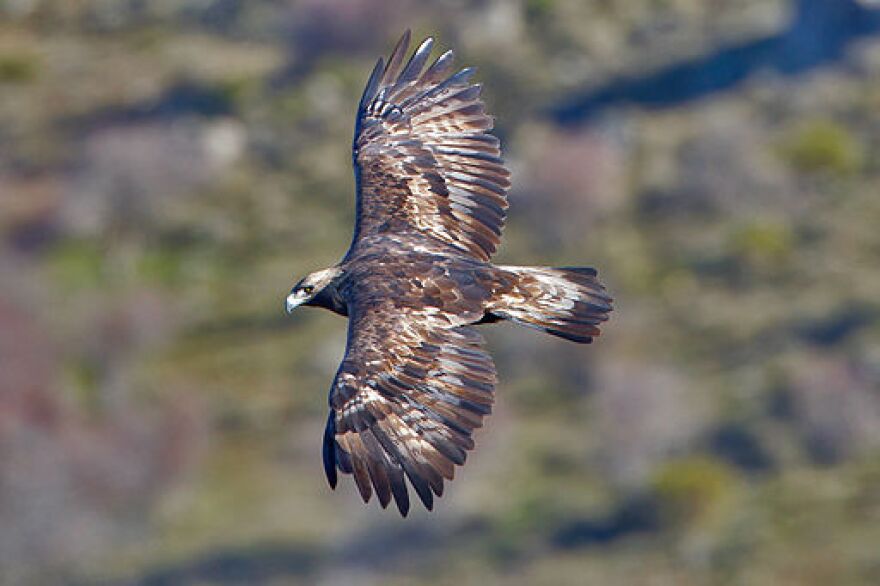There’s a celebratory mood in the air on this cold Saturday in February, in the Catskills town of Andes. Members of the Delaware Otsego Audubon Society, with help from the Department of Environmental Conservation, had for the first time trapped a golden eagle on its winter migration from Canada.
A veterinarian and a DEC biologist measure the surprisingly calm eagle, draw blood and attach a small tracking device to its back. This female is small for a golden eagle, with a 6-foot wingspan, weighting ten pounds, and with talons that are long and black and a bit terrifying.
Tom Salo is the research coordinator for the Audubon Society. Salo says there have been many challenges trapping one - they don’t always go for the bait.
“We’ve actually, at one of our sites, had golden eagles stop eating the venison bait we put out and start killing ravens and eating live ravens, which makes it a little harder for us to trap them,” says Salo.
But Salo’s patience is finally starting to pay off. Their goal is to attach tracking devices to a few golden eagles before they head back to Canada in the spring. A researcher at West Virginia University is leading the study, in hopes of learning more about the 2 to 5 thousand golden eagles that make their way through the eastern United States every winter.
Salo says that information could be very useful for wind farm developers in this part of the country.
“Because they are especially susceptible to impacts from wind power,” says Salo.
When they’re hunting, golden eagles fly low and keep their eyes on the ground, making wind turbines more of a hazard. And the tops of ridges, where updrafts provide reliable energy for turbines, also make good places for eagles to hunt. The same is true for other birds of prey.
The study’s lead researcher, Todd Katzner of West Virginia University, says golden eagles are a bigger concern in part because of arithmetic.
“So if you have 1,000 burrowing owls killed, that might be 1% of the burrowing owl population, whereas if you have 100 golden eagles killed that might be 5% of the population,” says Katzner.
So far, no eagle deaths from wind turbines have been reported in the Northeast. The goal of Katzner’s study is to identify the most dangerous places to put wind turbines, so at least the information is available to project planners.
There’s also a federal law - the Bald and Golden Eagle Protection – that makes it a crime to pursue, shoot at, poison, wound, kill, capture, trap, molest or disturb bald or golden eagles.
And last year, Duke Energy reached a $1 million settlement with the federal government, after 14 eagles were killed at two of its Wyoming wind farms. That fine was levied under the Migratory Bird Treaty Act. And the wind industry admits that its turbines pose some threat to birds.
“We are looking at somewhere around 200,000 birds a year or less that are taken at wind farms, around wind farms, across the country.”
That’s John Anderson, director of siting policy for the American Wind Energy Policy Association. Anderson says his association has issued guidelines for developers that aim to get in front of the problem.
“As part of that process set up under those guidelines, companies are required to spend at minimum a year- and often times longer- evaluating the potential for impacts to wildlife at a particular location,” says Anderson.
But wind farms aren’t required to get a permit to kill birds, known as a programmatic take permit.
Instead, the federal government tries to work with the developer early in the process. They encourage study of a proposed site to see if eagles are present. If there are eagles in the area, the Fish and Wildlife Service recommends ways to lower the risk – things like removing dead animals or in some cases shutting down the turbines at certain times of day when eagles are most likely nearby.
Sarah Nystrom from the Fish and Wildlife Service says the government strongly encourages developers to get in touch early if they might be affecting eagles.
“The other option, if the company says, hey, we’re not interested in this, then it does get referred to law enforcement and they can open a case and collect evidence,” says Nystrom.
Critics of this system say the federal government hasn’t gone far enough. Garry George is renewable energy director for the Audobon Society in California. George says the government should have applied the same restrictions that it does under the endangered species to protect eagles.
“In the endangered species act, you would see a recovery program, you would see analysis of the population in the region, you would see a biological analysis of how many eagles can be taken before the population is going to be a problem,” says George.
George estimates that about 500 eagles have died at wind power sites nationwide in the last decade, though there’s no exact number. He says his organization supports wind power over fossil fuels, but that the government could do more.



